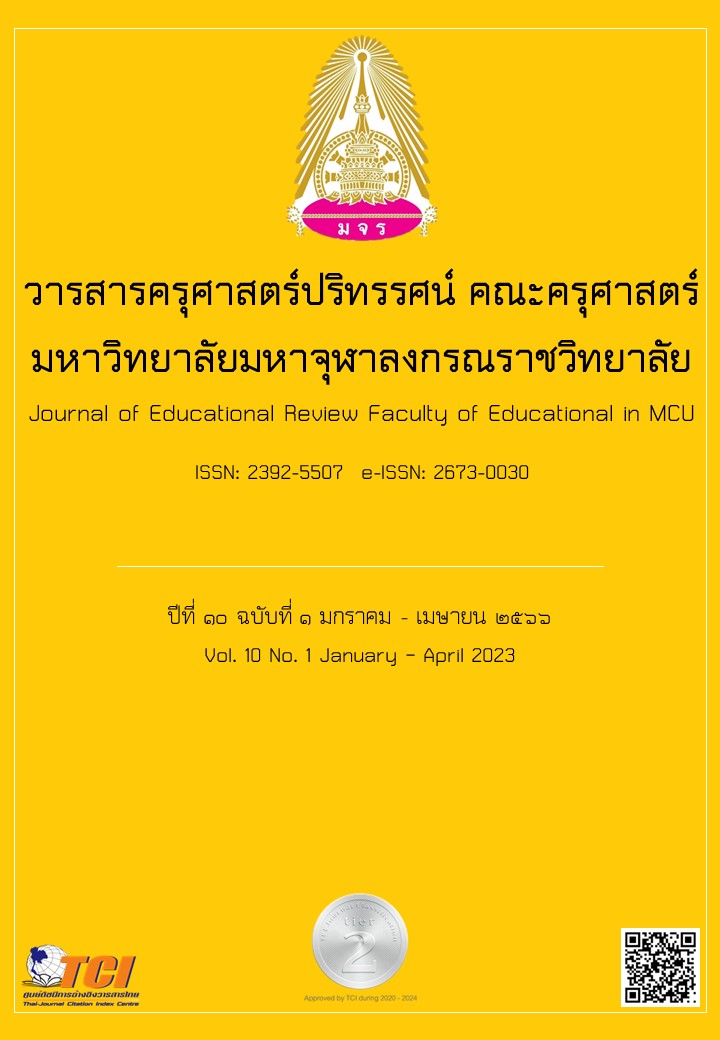DISRUPTIVE INNOVATOR SKILLS OF STUDENTS OF EDUCATION SANDBOX SCHOOLS UNDER THE SECONDARY SERVICE AREA OFFICE KANCHANABURI
Main Article Content
Abstract
The objectives of this research were 1) to study disruptive innovator skills of students of education sandbox schools under the secondary service area office Kanchanaburi, and 2) to compare disruptive innovator skills of students of education sandbox schools under the secondary service area office Kanchanaburi according to their gender and education level of students. This is a survey research, and the research tool was a questionnaire. Data were collected from 375 samples of students of education sandbox schools under the secondary service area office Kanchanaburi in academic year 2021. The data were analyzed by using descriptive statistics of, frequency, percentage, means, and standard deviations, and inferential statistics of independent Two-way ANOVA and Scheffe’s Method. The research results were as follows: 1) Disruptive Innovator Skills of students of Education Sandbox Schools under The Secondary Service Area Office Kanchanaburi in overall and each aspect was at a high level, ranking the mean scores from high to low were as follows: Observing skill, Associating skill, Experimenting skill, Networking skill and Questioning skill. 2) Disruptive innovator skills of students of education sandbox schools under The Secondary Service Area Office Kanchanaburi among different genders in overall showed no statistically significant difference at .05 level. 3) Disruptive innovator skills of students of education sandbox schools under The Secondary Service Area Office Kanchanaburi different education levels in overall were statistically significant difference at .05 level.
Article Details

This work is licensed under a Creative Commons Attribution-NonCommercial-NoDerivatives 4.0 International License.
ทัศนะและความคิดเห็นที่ปรากฏในบทความในวารสารฉบับนี้ถือเป็นความรับผิดชอบของผู้เขียนบทความนั้นเพียงผู้เดียว และไม่ถือเป็นทัศนะและความรับผิดชอบของกองบรรณาธิการ
กองบรรณาธิการขอสงวนสิทธิ์ในการคัดเลือกบทความลงตีพิมพ์และจะแจ้งให้เจ้าของบทความทราบหลังจากผู้ประเมินบทความตรวจอ่านบทความแล้ว
ต้นฉบับที่ได้รับการตีพิมพ์ในวารสารครุศาสตร์ปริทรรศน์ คณะครุศาสตร์ มหาวิทยาลัยมหาจุฬาลงกรณราชวิทยาลัย ถือเป็นกรรมสิทธิ์ของคณะครุศาสตร์ มหาวิทยาลัยมหาจุฬาลงกรณราชวิทยาลัย ห้ามนำข้อความทั้งหมดหรือบางส่วนไปพิมพ์ซ้ำ เว้นเสียแต่ว่าจะได้รับอนุญาตจากมหาวิทยาลัยฯ เป็นลายลักษณ์อักษร
References
เกษมสุข เฉลียวศักดิ์. (2542). เอกสารประกอบการสอน จิตวิทยาพัฒนาการสำหรับครู. สงขลา: คณะศึกษาศาสตร์ มหาวิทยาลัยทักษิณ.
ณิชากร ศรีเพชรดี. (2562). โลกไม่สนใจว่าเรารู้อะไรแต่สนใจว่าเราทำอะไรกับสิ่งที่รู้: บันไดขั้นแรกสู่ YOUNG INNOVATOR. แหล่งที่มา https://www.thepotential.org/ knowledge/play-passion-purpose-young-innovator สืบค้นเมื่อ 1 ต.ค. 2564.
ธนกฤตา แจ่มด้วง. (2560). แนวทางพัฒนาทักษะการเรียนรู้และนวัตกรรมของนักศึกษามหาวิทยาลัยศิลปากรตามนโยบายประเทศไทย 4.0. วิทยานิพนธ์ศึกษาศาสตรมหาบัณฑิต. มหาวิทยาลัยศิลปากร.
พฤทธิ์ ศิริบรรณพิทักษ์. (2563). ความสำคัญของนวัตกรรมพลิกผันและนวัตกรพลิกผัน. วารสารบริหารและนวัตกรรมการศึกษา. 3(3). 3-4.
พาสนา จุลรัตน์. (2548). จิตวิทยาการศึกษา. กรุงเทพมหานคร: มหาวิทยาลัยศรีนครินทรวิโรฒ.
ยูนิเซฟประเทศไทย. (2562). รานงานประจำปี 2562. แหล่งที่มา https://www.unicef.org/thailand/th สืบค้นเมื่อ 28 ก.ย. 2564.
วรชัย สิงหฤกษ์. (2562). ปัจจัยที่มีอิทธิพลต่อพฤติกรรมการสร้างสรรค์นวัตกรรมของเจ้าหน้าที่สหกรณ์การเกษตรในจังหวัดเพชรบุรี. วารสารอิเล็กทรอนิกส์การเรียนรู้ทางไกลเชิงนวัตกรรม. 9(2). 77-90.
วิชัย วงษ์ใหญ่ และมารุต พัฒผล. (2562). การจัดการเรียนรู้ในยุค Disruptive Innovation. กรุงเทพมหานคร: ศูนย์ผู้นำนวัตกรรมหลักสูตรและการเรียนรู้.
ศิวรรณ อะวะตา. (2563). ปัจจัยเชิงสาเหตุและแนวทางการพัฒนาการคิดแก้ปัญหาอย่างสร้างสรรค์ของนักเรียนชั้นมัธยมศึกษาปีที่ 4 สำนักงานเขตพื้นที่การศึกษามัธยมศึกษา เขต 21. วารสารการวัดผลการศึกษา มหาวิทยาลัยมหาสารคาม. 26(1). 239-256.
สำนักงานคณะกรรมการพัฒนาการเศรษฐกิจและสังคมแห่งชาติ. (2559). แผนพัฒนาเศรษฐกิจและสังคมแห่งชาติ ฉบับที่สิบสอง. กรุงเทพมหานคร: สำนักนายกรัฐมนตรี.
สำนักงานบริหารพื้นที่นวัตกรรมการศึกษา. (2562). สถานศึกษานำร่องในพื้นที่นวัตกรรมการศึกษา. แหล่งที่มา https://www.edusandbox.com สืบค้นเมื่อ 30 ก.ย. 64.
สำนักงานเลขาธิการสภาการศึกษา. (2560). แผนการศึกษาแห่งชาติ พ.ศ.2560-2579. แหล่งที่มา https://www.moe.go.th/มาตรฐานการศึกษาของชาติ สืบค้นเมื่อ 28 ก.ย. 2564.
สำนักงานเลขาธิการสภาการศึกษา. (2561). มาตรฐานการศึกษาของชาติ พ.ศ.2561. แหล่งที่มา http://www.lertchaimaster.com/doc/The-national-educational-standards-oct2561.pdf สืบค้นเมื่อ 28 ก.ย. 2564.
สำนักงานศึกษาธิการจังหวัดกาญจนบุรี. (2563). ข้อมูลสารสนเทศด้านการศึกษา จังหวัดกาญจนบุรี ปีการศึกษา 2563. แหล่งที่มา https://www.kanpeo.go.th/home สืบค้นเมื่อ 30 ก.ย. 2564.
สำนักงานศึกษาธิการจังหวัดกาญจนบุรี. (2563). แนวทางการขับเคลื่อนพื้นที่นวัตกรรมการศึกษา. แหล่งที่มา https://www.kanpeo.go.th/home สืบค้นเมื่อ สืบค้นเมื่อ 30 ก.ย. 2564.
สำนักงานสถิติจังหวัดกาญจนบุรี. (2561). สถานการณ์ความยากจนและความเหลื่อมล้ำ จังหวัดกาญจนบุรี. แหล่งที่มา http://kanchanaburi.nso.go.th สืบค้นเมื่อ สืบค้นเมื่อ 30 ก.ย. 2564.
สุกัญญา แช่มช้อย. (2563). นวัตกรรมการบริหารโรงเรียนมัธยมศึกษาเพื่อสร้างนวัตกร. วารสารศึกษาศาสตร์ มหาวิทยาลัยนเรศวร. 22(2). 193-213.
Best, J. W. (1981). Research in education. New Jersey: Prentice Hall.
Chell, E., & Athayde, R. (2009). The identification and measurement of innovative characteristics of young people: Development of the youth innovation skills measurement tool. NESTA.
Dyer, J. H., Gregersen, H., & Christensen, C. M. (2009). The Innovator’s DNA. Harvard Business Review. From https://www.hbr.org/2009/12/the-innovators-dna Retrieved October 9, 2021.
Ferreras-Garcia, R., Sales-Zaguirre, J., & Serradell-López, E. (2021). Sustainable innovation in higher education: the impact of gender on innovation competences. Sustainability, 13(9). 5004.
Krejcie, R. V. & Morgan, D. W. (1970). Determining Sample Size for Research Activities. Educational and Psychological Measurement. 30(3). 607-610.
Stobierski T. (2021). 3 disruptive strategy skills for entrepreneurs and business leaders. From https://www.online.hbs.edu/blog/post/disruptive-strategy-skills Retrieved January 12, 2022.


